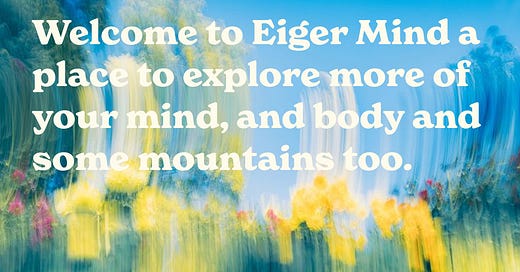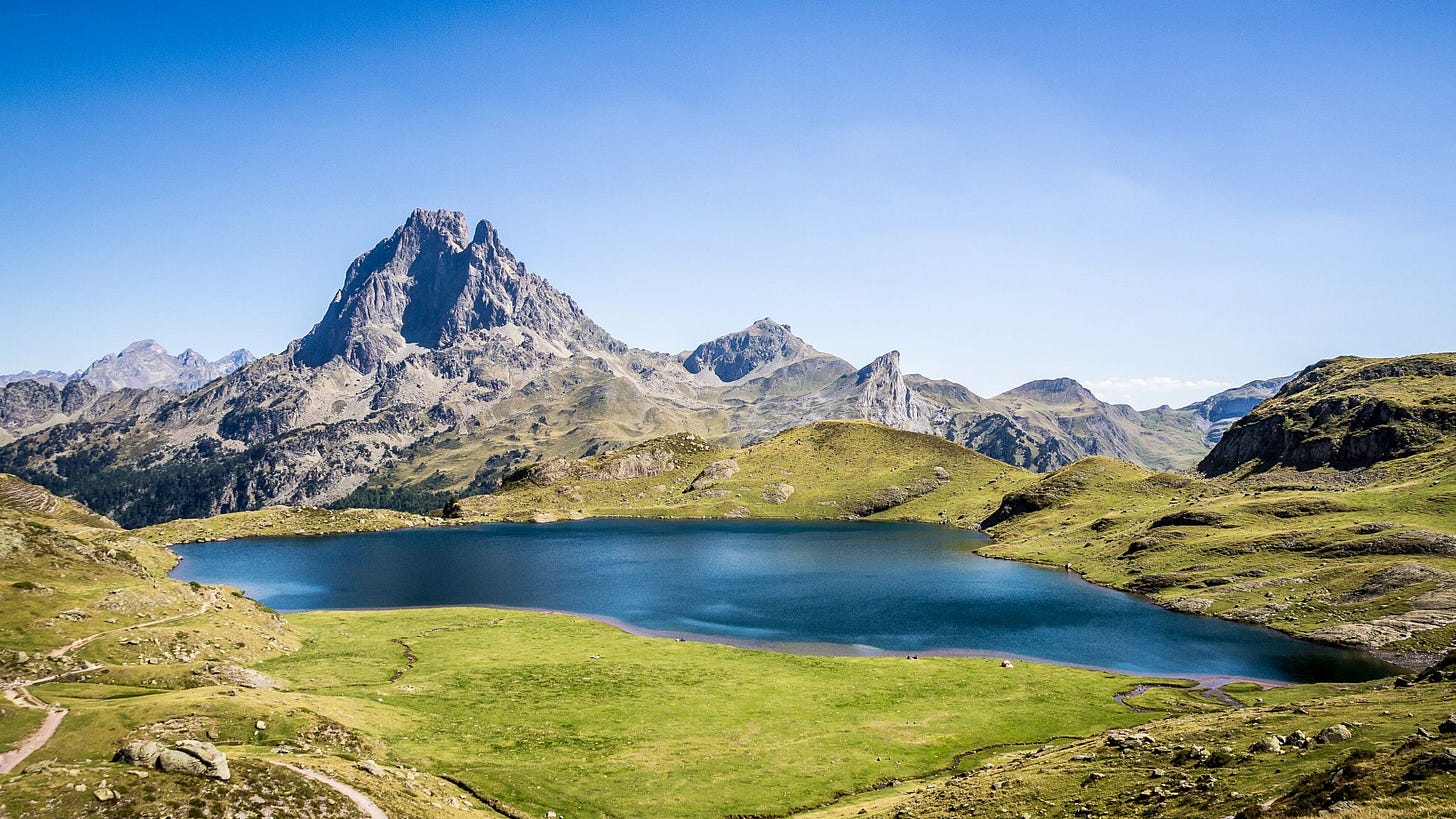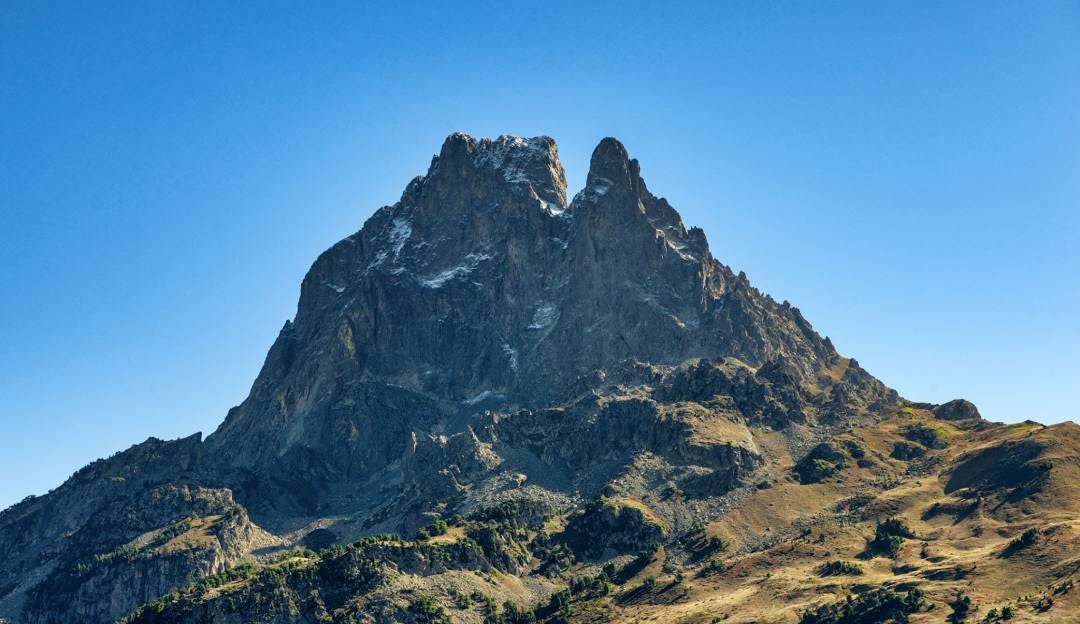Dear reader,
Over the past few years, Uncle has grown into something I’m very proud of. A weekly dose of mind wanderings and mountain-side conversations. I try to challenge and support how we can view the adventure of being alive. Many of you have written to me to say how much a post has resonated with you, and those words have inspired me to keep going.
Now, it’s time for Uncle to evolve.
From this week forward, Uncle will continue under a new name: Eiger Mind.
If you’re already subscribed, there’s nothing you need to do. You can expect the same writing (and more), the same spirit, the same attempt to make life feel a little more meaningful—just under a new name.
Why the change?
Eiger Mind (pronounced “I-ger” like the mountain) is my coaching and training project focusing on physical fitness, mental training, and spiritual freedom. It was initially meant to live alongside this writing. But increasingly, the line between physical training, spiritual inquiry, and mountain climbing has blurred—isn’t it all the same anyway? So instead of keeping them apart, I’m bringing them together.
What you can now expect each week from Eiger Mind:
— Essays on the Mind: Just like you’re used to.
— A Mountain to Know: Climbing routes, alpine history, local wildlife, and tales of adventure.
— Training Weekly (*new to the family): a simple, actionable weekly schedule for physical and mental training.
Eiger Mind is about movement, awareness, resilience, connection with nature, and holistic strength—mental, physical, and emotional. The same themes you’ve come to expect from Uncle, with even more tools to help you live with clarity and vitality.
THANK YOU for being here. I cannot express my gratitude.
And now, without further delay, here are some bits of inspiration I found this week.
The Practice Requires Participation
There’s a line Adyashanti shared in a talk i heard recently that’s been echoing in me all week:
“We must be willing to participate in the practice.”
Full participation is not a dabble. It’s not waiting until life gets hard.
Because this path—the path of strength, clarity, resilience, and awareness—doesn’t arrive by accident. It evolves through our attention. Through our willingness to train, everyday, again and again. Not just when things fall apart, but when things are steady. Indeed especially when they’re steady, because that’s the only time when training is possible. We need time and rest and focused attention, we need time under tension to break down and regrow.
It’s a misconception (a common one) to think we can begin training only when we need it. You don’t build muscle the moment your legs give out. You don’t build awareness the second your mind is spinning with anxiety. Strength—physical and mental—is built in the in-betweens. It’s built daily.
Training under tension is how we build strength. Progressive overload increases that strength, the power. That goes for squats, jumps, and deadlifts, and it goes for meditation, silence, and self-regulation. We participate to grow. And that participation is the practice. In fact, it is life, if you look closely enough. Because anything less is life-limited.
Without practice, we’re fragile. Ungrounded. We’re easy targets for life's inevitable surprises—injury, stress, disappointment. But when we train consistently, when we choose to participate even when it’s inconvenient, the ground shifts and we become the foundation. The practice stops being a chore and starts becoming fuel for itself. Momentum builds. And that energy begins to shape our entire experience—our choices, our relationships, our posture, our presence.
So how do we find, and then establish this kind of participation?
It starts with curiosity. With experimentation. With paying attention to what moves us and what grounds us. Everyone is unique, thank goodness, and it’s different for us all. But there is one common denominator: consistency.
If you already have a practice that feeds you strength, calm, creativity—fantastic. Keep going. Deepen it. Share it.
But if you don’t—maybe this is the week to begin. Try something:
Journaling for five minutes in the morning can be surprisingly revealing.
Moving your body in a way you haven’t tried in years. When was the last time you hung on a bar for as long as possible, or climbed a tree like a monkey?
Picking up a book that inspires reflection or boldness, if you can’t think of one, just ask me for some recommendations.
Take a walk in silence without your phone.
Sitting beneath a tree and simply observing, breathing deeply for 5 minutes.
See what arises. See how it makes you feel. After some time, maybe a few weeks, is there something that keeps arising? Some topic, idea, expression, or movement. That’s the signal. Keep chasing that signal.
And when it lands, I’d love to hear about it. This is a shared path after all, even if we walk it in our own ways, we’re all here together.
Your practice is waiting. And it’s seriously exciting because it’s all yours and it can take you places you might never have imagined.
Participation is the door.
A Mountain to Know: Pic du Midi d'Ossau (2,884m)
French Pyrenees, Nouvelle-Aquitaine region
Rising like a storybook tower with a queen at the summit (instead, just a bunch of smelly climbers) — dramatic, and lopsided in form. A volcanic relic in a land of sedimentary giants, Pic du Midi d’Ossau is one of the most iconic mountains in the French Pyrenees. Locals call it Jean-Pierre (no one really knows why), and its twin-pronged summit is visible for miles across Béarn and beyond.
Though under 3,000m, Ossau punches far above its weight. With a jagged profile and moat-like isolation (a relic of its volcanic neck formation), it feels Himalayan in character.
CLIMBING ROUTES
While Pic du Midi d’Ossau is not a beginner’s peak, it’s accessible to any experienced scrambler or alpinist with a head for exposure and a rope for the descent.
Standard Route (Voie Normale / South-East Ridge)
Grade: PD / II-III, approx. 6–8 hrs round trip
Start from Refuge de Pombie (2,031m), reached in about 90 minutes from the Aubisque side or the Bious-Artigues dam (a scenic lake start). From the refuge, traverse west and then ascend three separate chimneys, all requiring Class III scrambling and light rope work depending on the conditions and party comfort level. The rock is solid volcanic and often dry in summer.
The final summit push offers narrow ridges and a glorious wind-swept perch between the twin peaks. Rope descent recommended via the same route; many climbers rappel the chimneys.
Arête de Peyreget and other ridges (AD and up)
For more technical ascents, routes like the Northwest Ridge or Fourche Couloir add some alpine spice, involving mixed conditions and longer exposure. These are best with a local guide or for those confident with alpine trad protection.
STAY & LOGISTICS
Base yourself in Laruns, a charming alpine village with excellent food and a clear Ossau view.
Refuge de Pombie is open June to late September. Excellent mountain food, beds, and topo advice.
Summer (July–early September) offers the safest window for scrambling. Snow lingers on the north-facing sections until late June.
FLORA & FAUNA
Wild isards (Pyrenean chamois) are frequently seen bounding across the high meadows near Refuge de Pombie.
In summer, edelweiss, alpine asters, and saxifrage dot the trailsides.
Keep an ear out for the whistling marmots, and watch the skies for bearded vultures (lammergeier) — they nest in the cliffs near Ossau and are among Europe’s rarest and most spectacular birds.
LOCAL HISTORY & MYTH
Ossau has long been a boundary marker — straddling Béarn and the Basque Country, Catholic and pagan traditions. In ancient lore, it was the home of Basajaun, the “wild man of the woods,” a forest spirit and protector of nature.
In the 19th century, British climbers including Henry Russell made repeated visits, documenting their ascents in lyrical journals — and helping birth “Pyreneism”, a movement as much about aesthetic experience and natural awe as technical climbing.
During WWII, this region was also a discreet escape corridor for Allied airmen and Jews fleeing across the Spanish border. Many passed beneath the shadow of Ossau, hidden by local shepherds.
A Pic Worth Picturing
Ossau reminds us what mountains don’t need huge elevation to invite our senses — rising like a riddle, she holds history and mystery in equal parts. She doesn’t demand conquest, only presence, and a nice long day out in the hills.
Why not get to know it by climbing it. Or by walking around its base. Or by sitting with your back against a pine tree below its eastern wall and just watching the light shift across its flanks.







